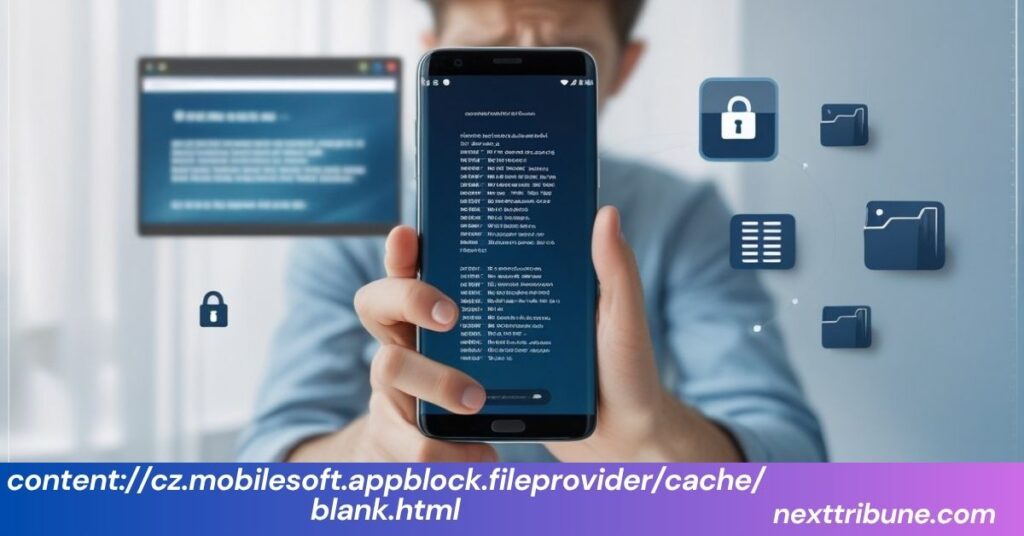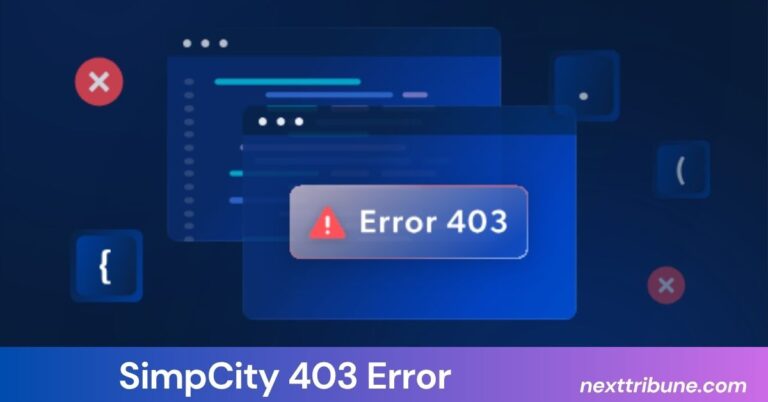
In the world of mobile applications, certain processes and technicalities often go unnoticed by the average user. However, understanding these behind-the-scenes operations can offer valuable insights into how apps function and how they impact user experience. One such instance is the content://cz.mobilesoft.appblock.fileprovider/cache/blank.html URI, which plays a pivotal role in the AppBlock app on Android devices. While this may sound like an obscure technical detail, it has significant relevance to how AppBlock operates to manage app usage and ensure productivity.
In this comprehensive article, we will explore the concept of content cz mobilesoft appblock fileprovider cache blank html, its functionality, and how it helps the AppBlock app in achieving its core objectives. We’ll also answer common questions about this URI and its connection to temporary cached HTML files, helping users and developers better understand how it fits into the broader scope of Android apps.
What is AppBlock, and How Does it Work?
Before diving into the specifics of content://cz.mobilesoft.appblock.fileprovider/cache/blank.html, it is important to first understand the purpose and functionality of the AppBlock app. AppBlock is a productivity and focus-driven app designed to help users manage distractions by blocking access to certain apps. This is particularly useful for individuals who wish to reduce their screen time, stay focused, or avoid apps that tend to divert their attention.
The app works by creating profiles where specific apps can be blocked either for a set period or based on custom usage rules. This helps users enhance their productivity and avoid getting sidetracked by social media, games, or other distractions. AppBlock has gained popularity because of its straightforward approach to reducing app usage and promoting focus.
However, like many Android apps, AppBlock utilizes content URIs to access and store temporary data on the device, and content://cz.mobilesoft.appblock.fileprovider/cache/blank.html is one such URI.

What Does “content://cz.mobilesoft.appblock.fileprovider/cache/blank.html” Represent?
At its core, content://cz.mobilesoft.appblock.fileprovider/cache/blank.html is a content URI used by the AppBlock app on Android. A content URI is a standard Android method for sharing data between different apps or accessing specific files within an app’s internal storage.
Also Read: Thomas Boone Quaid: A Journey Through Life’s Challenges
The URI content cz mobilesoft appblock fileprovider cache blank html specifically points to a temporary cached HTML file, usually empty or blank, stored within AppBlock’s directory structure. This file is used by the app for specific tasks related to blocking apps and managing the user’s session.
The “blank.html” aspect of the URI is indicative of a file that typically does not contain any visible content for the user. Instead, it serves a technical purpose. In this case, the file acts as a placeholder or a temporary buffer that allows AppBlock to perform certain operations seamlessly without causing any disruption or visible notification to the user.
Why is This URI Important for AppBlock?
The use of content://cz.mobilesoft.appblock.fileprovider/cache/blank.html helps AppBlock manage cached data more efficiently. By storing a blank HTML file in the cache, the app is able to process information without overwhelming the device with additional files. This improves performance and minimizes storage usage, which is particularly important for devices with limited memory.
Additionally, this cached file plays a role in preventing users from accessing blocked content. When a user tries to open a restricted app or service, the app might redirect to this cached blank HTML file as a means of blocking the user from accessing the app directly. This approach allows AppBlock to maintain focus and productivity goals while reducing distractions.
Technical Breakdown of the URI
Let’s break down the URI content://cz.mobilesoft.appblock.fileprovider/cache/blank.html into its components to understand it more clearly.
- content://: This part of the URI scheme specifies that the URI is referencing content rather than a regular file path. The “content://” scheme is often used in Android to interact with content providers, which are standardized interfaces for data access between apps.
- cz.mobilesoft.appblock.fileprovider: This refers to the specific content provider used by the AppBlock app. “cz.mobilesoft” is likely the app’s developer or package identifier, and “fileprovider” specifies that the URI points to a file provider, which is a component in Android used to safely share files between apps.
- cache: This folder typically stores temporary files that are not essential for the app’s core functionality but help in improving performance or efficiency. Cached files can be cleared periodically, so they don’t consume excessive storage.
- blank.html: As mentioned earlier, this is the actual file the URI points to. It is often empty or contains minimal content, serving more as a placeholder or a functional part of AppBlock’s mechanism for blocking apps and services.
Also Read: Increase Online Sales by Garage2Global: Proven Strategies to Grow Your Business
How Does AppBlock Use “content cz mobilesoft appblock fileprovider cache blank html”?
AppBlock uses this URI for several reasons:
- Temporary Cache Management: The blank HTML file acts as a temporary storage space for the app. It doesn’t contain useful content for the user but helps the app store data that it needs for operational purposes, like blocking specific apps.
- App Blocking Process: When AppBlock activates the blocking mechanism, the app may redirect the user to this blank file as part of the process. This prevents the user from seeing any content from the blocked app and maintains focus by essentially rendering the app inaccessible.
- Minimal Resource Usage: By using a cached blank HTML file, AppBlock minimizes resource consumption. The file is lightweight and does not use up valuable memory or processing power. This helps the app run efficiently on a variety of Android devices.
The Role of Caching in AppBlock’s Performance
Caching is a critical component in many mobile apps, and AppBlock is no exception. Caching allows the app to store frequently used data temporarily, which leads to faster access times and reduced server load. For AppBlock, caching is essential for ensuring smooth and efficient app blocking, as the app needs to load and interact with its settings quickly.
By utilizing the content://cz.mobilesoft.appblock.fileprovider/cache/blank.html URI, AppBlock ensures that it operates without significant lag, even when performing complex blocking tasks. Additionally, this helps reduce the app’s reliance on the network, making the blocking process more reliable and instantaneous.
Privacy and Security Considerations
It is important to highlight that the use of content URIs like content cz mobilesoft appblock fileprovider cache blank html is governed by Android’s security and privacy policies. Content URIs are designed to protect users by preventing unauthorized access to private files. Only apps with the proper permissions can access and manipulate files referenced by these URIs. This ensures that even if a malicious app were to try and interact with AppBlock’s files, it would not be able to access or modify them without the necessary permissions.
For users concerned about privacy, it’s also worth noting that the blank.html file is temporary and generally does not contain any personally identifiable information or sensitive data. Its purpose is functional rather than storing personal data.
Also Read: Samigo App: Everything You Need to Know
Frequently Asked Questions (FAQs)
What is the significance of content://cz.mobilesoft.appblock.fileprovider/cache/blank.html in AppBlock?
This URI points to a cached HTML file that AppBlock uses to block access to specific apps. It serves as a placeholder, ensuring users cannot interact with restricted apps while maintaining the performance of the AppBlock app.
Why does AppBlock use a blank HTML file in its cache?
The blank HTML file helps AppBlock maintain performance by serving as a lightweight placeholder for temporarily blocking apps. It does not contain visible content for the user but is essential for the app’s functionality.
Is the cached blank HTML file accessible to other apps on my Android device?
No, the cached blank HTML file is stored in a secure area of your device that is managed by the AppBlock app. Only apps with the proper permissions can access it.
How does caching improve the performance of AppBlock?
Caching allows AppBlock to store data temporarily for faster access and smoother performance. It reduces the need to constantly fetch data from the network, ensuring a more seamless user experience when blocking apps.
Can I delete the cached file from AppBlock?
While you technically could delete cached files from your device’s storage, it’s not recommended as it may affect the functionality of AppBlock. Cached files are temporary and are managed by the app to optimize performance.
Conclusion
The content://cz.mobilesoft.appblock.fileprovider/cache/blank.html URI is an important part of how the AppBlock app operates, especially in terms of caching and app blocking. It plays a significant role in ensuring that users can stay focused and avoid distractions, all while maintaining a smooth and efficient user experience.
By understanding the technicalities of this URI, users can appreciate how AppBlock functions in the background and how it helps achieve its productivity goals. The use of temporary cached files like blank.html is a smart way to manage resources and improve performance without compromising on functionality. Whether you’re a developer looking to implement similar functionality or a user wanting to understand how the app works, this article provides a comprehensive overview of this seemingly small but vital part of AppBlock.



